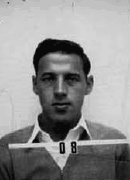Julius Ashkin
Julius Ashkin (born August 23, 1920 in Brooklyn ; † June 4, 1982 ibid) was an American theoretical and experimental physicist.
His father Isadore emigrated from Odessa to the USA and ran a dental technology laboratory. Ashkin studied from 1936 at Columbia University , where Enrico Fermi , Isidor Isaac Rabi , Arnold Nordsieck (and Edward Teller and Hans Bethe as visiting professors) were among his teachers. He received his bachelor's degree in 1940 and his master's degree in 1941, and in 1943 he received his doctorate in physics from Willis Lamb . He worked in the Manhattan Project from 1943 to 1946 , first in Chicago at the Metallurgical Laboratory and from mid-1943 at the Los Alamos National Laboratory in the group for experimental nuclear physics and then in the theory department under Hans Bethe and in the group of Richard P. Feynman , where he Calculated and critical masses for diffusion of neutrons. In 1946 Robert Marshak brought him to the University of Rochester as an assistant professor . From 1950 he was at Carnegie Mellon University , where he became a professor and from 1961 to 1972 headed the physics faculty.
He dealt with elementary particle physics, nuclear physics and statistical mechanics.
At Columbia University, he and Edward Teller developed the Ashkin-Teller model, a variant of the Potts model and an extension of the Ising model . In his dissertation with Lamb, he dealt with the propagation of order in crystal lattices. With Bethe he wrote a handbook article on the energy loss of particles in interaction with matter, which is important for experimenters, a topic that Bethe had already worked on. With TY Wu he made one of the first detailed calculations of nucleon-nucleon scattering. In 1952, with Lincoln Wolfenstein , he found that parameters in polarized scattering were tests for time-reversal invariance. After Richard P. Feynman he was one of the first to use his Feynman diagrams .
At Carnegie Mellon University, he turned to experimental particle physics at the 450 MeV proton synchrocyclotron in Saxenburg. In the early 1950s he made precise measurements of the scattering of charged pions on hydrogen and deuterium. He also found evidence (like Enrico Fermi's group in Chicago before ) on the delta resonance (published 1954).
In 1958/59 he spent a sabbatical year at CERN , where he was involved in some of the first experiments on the 600 MeV synchrocyclotron. These experiments on the decay of the pi meson, observing the decay into an electron and neutrino and its rate, confirmed the VA theory of the weak interaction.
In 1968 he was a Guggenheim Fellow at All Souls College, Oxford.
His brother Arthur Ashkin is also a physicist. He was married to Clare Ashkin and had two daughters.
Fonts
- with W. Lamb: The propagation of order in crystal lattices, Phys. Rev., Vol. 64, 1943, pp. 159-178
- with E. Teller: Statistics of Two-Dimensional Lattices with Four Components, Phys. Rev., Volume 64, 1943, p. 178
- with Ta-You Wu: Neutron-Proton and Proton-Proton Scattering at High Energies, Physical Review, Volume 73, 1948, pp. 973-985.
- with Ta-You Wu: Elastic and Inelastic Scattering of 100- to 200-Mev Protons or Neutrons by Deuterons, Physical Review, Volume 73, 1948, pp. 986-1001.
- with R. Marshak: Bremsstrahlung in High Energy Nucleon-Nucleon Collisions, Physical Review, Volume 76, 1949, pp. 58-60.
- with L. Wolfenstein: Invariance Conditions on the Scattering Amplitudes for Spin ½ Particles, Phys. Rev., Vol. 85, 1952, p. 947
- with Bethe: Passage of Radiations Through Matter, in Emilio Segré (Ed.), Experimental Nuclear Physics, Volume 1, Wiley 1953
- with A. Simon, R. Marshak: On the Scattering of pi-Mesons by Nucleons, Progress of Theoretical Physics, Volume 5, 1950, pp. 634-668.
- with JP Blaser, F. Feiner, JG Gorman, MO Stern: Total Cross Sections for Negative and Positive Pions in Hydrogen and Deuterium, Phys. Rev. Volume 96, 1954, pp. 1104-1115, abstract
- with T. Fazzini, G. Fidecaro, AW Merrison, H. Paul, AV Tollestrup: The electron decay mode of the pion, Il Nuovo Cimento, Volume 13, 1959, pp. 1240-1262.
- Pion-nucleon scattering, Il Nuovo Cimento, Volume 14, 1959, S2, pp. 221-241.
- with T. Fazzini, G. Fidecaro, Y. Goldschmidt-Clermont, NH Lipman, AW Merrison, H. Paul: A new measurement of the mean life of the positive pion, Il Nuovo Cimento, Volume 16, 1960, p. 490– 504
Web links
Individual evidence
- ^ Title of the dissertation: Two problems in the statistical mechanics of crystals. I. The propagation of order in crystal lattices II. The statistics of two-dimensional lattices with four components . After that, the Ashkin Teller model was also part of the dissertation.
- ^ Feynman, Oral History Interview with Charles Weiner 1966, Online .
- ↑ Klaus Winter, Experimental Studies of Weak Interactions, in: J. Krige (Ed.), History of CERN, Volume 3, Elsevier 1996, p. 416.
| personal data | |
|---|---|
| SURNAME | Ashkin, Julius |
| BRIEF DESCRIPTION | American physicist |
| DATE OF BIRTH | 23rd August 1920 |
| PLACE OF BIRTH | Brooklyn |
| DATE OF DEATH | 4th June 1982 |
| Place of death | Brooklyn |
